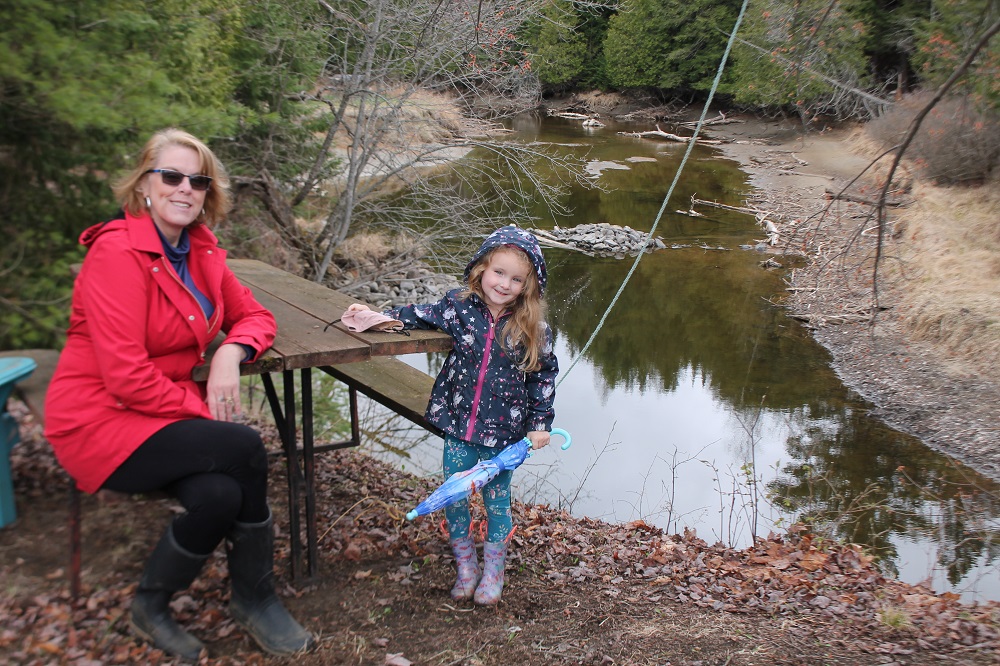Sherry Mulholland says the Gull River has never been so low at her Pine Lake home.
Overlooking the river from her property, there’s as much shoreline and muddy banks as there is water.
Mulholland says they draw their household water from the river that runs between the Eagle Lake dam and Pine Lake. They don’t drink it but are concerned about the source of the filtered water they use for washing dishes and doing laundry.
They’re also worried about recreational impacts with the water so low. Right now, it couldn’t sustain inner tubes or the rope jump from their tree. It wouldn’t be deep enough to swim or for the aluminium boats.
“It is so low. I have never seen it like this. There are more sand banks than water. Unbelievable,” Mulholland said April 17.
Algonquin Highlands Mayor Carol Moffatt discussed the low water level situation on her mayoral Facebook page April 13.
She said there’s been a 50 per cent shortfall in spring rains as of mid-April with temperatures above normal.
“The freshet was almost non-existent, certainly in comparison with recent years,” she added.
Seasonal levels expected for summer
Moffatt said some inconsistencies in usual runoff patterns, or how lakes usually fill up, is happening.
As a result, she said the Upper Gull was only 70 per cent full; Kennisis, Hawk and Kushog needed water and dams were closed off but operations at Red Pine and Nunakani were expected to see those lakes come up; the Maple chain is very low and one example of the inconsistent runoff patterns.
Moffatt noted it is still more than four weeks to the May 24 weekend “when it’s expected that the whole system will be full.”
Ted Spence is chair of the Coalition of Equitable Water Flow (CEWF).
He said on April 19 that “The most important point right now is that with the prolonged period without significant rain on top of a relatively dry early winter and spring, the local inflows to most lakes are very low and the levels are now dipping below normal levels for this date.”
Like Moffatt, he said the snowmelt was early and we have had very little rain.
“We clearly need significant rain to bring us to normal levels by the end of May.”
Spence said the Trent Severn Waterway (TSW) has added logs to all dams throughout the spring and stands ready to store water when it is available.
“The relatively low flows on the Gull River in Minden which have persisted for most of the last several weeks are evidence that the available flows have been managed to fill reservoirs where possible,” Spence said.
“But at this point the whole system including the Kawartha lakes are in need of significant inflows. We need some significant rainfall events.”
The TSWs Karen Feeley said water levels and flows fluctuate for several reasons. She said typically, watersheds rise or refill in the spring depending upon the rate and volume of snowmelt and spring rainfall.
“The total precipitation for this past winter was 25 per cent less than normal values, followed by 25-50 per cent less than normal amounts of precipitation in March. The watersheds experienced an earlier than normal freshet, which, combined with sustained warmer air temperatures, has resulted in the aggressive loss of winter snowpack during late March and melt runoff recession in early April,” she said.
Feeley added that since early March, higher temperatures and moderate winds have contributed to further losses of local inflows, and much of the runoff was absorbed by the soil.
However, she said on April 21 that water levels across the watershed are currently rising and, presuming a normal amount of precipitation throughout the month of April, the public can expect the current lake levels to continue to rise during May, achieving seasonal averages heading into summer.
Maple Lake seasonal resident, Char Booth Vitez, said she hopes conditions improve.
“We have many concerns about the water levels in our lake,” she said.
“Docks are sitting in sand and there’s no chance of moving them without water levels rising. Unlikely we will get boats launched as the river will be too low to navigate,” she added.





